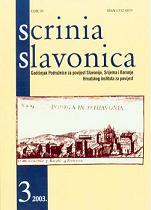Djelovanje Seljačke sloge u Slavoniji, Srijemu i Baranji (1925.-1941.)
Activities of Seljacka sloga organization in Slavonia, Srijem and Baranya (1925-1941)
Author(s): Suzana LečekSubject(s): History
Published by: Hrvatski institut za povijest
Keywords: Croatian Peasants’ Party; Seljačka sloga; Peasants’ Unity organization; village; peasantry; education; economic help; traditional culture; art; s hows
Summary/Abstract: In a very short period of its work (1925 – 1929 and 1935 – 1941), Seljačka sloga developed various forms of activities in the field of culture, education and economy. The main types and principles on which these activities had been carried on had been adopted by the year of 1929 and later, during the 1930s, they were either repeated or expanded. Most of its activities were taken over from various former citizens’ associations (in particular a so-called ABC club and the Croatian Society for People’s Education). However, in following Antun Radić’s teaching, it gained its own fresh content and new bearers of the ideas and strived for peasants to become agents in both culture and politics.[...] In view of the fact that all these institutions functioned in special circumstances in the Kingdom of Serbs, Croats and Slovenes, in which the opposition lead by the Croatian Peasants’ Party assumed the people’s (peasants’) character, the attendance was so remarkable that even the state bodies would not have been able to attract so many participants. Thanks to Seljačka sloga more than 300.000 people became literate, many reading sessions were held and the books for modestly furnished libraries in the villages were acquired, where many had the opportunity to acquire knowledge necessary for a decent living. [...]. Slavonia showed its unique qualities in this field. The literacy movement in Slavonia steamed ahead of other regions and prizes for the highest levels of literacy in the country were regularly awarded to its branches. Besides, Slavonia produced quite a large number of authors who contributed to the activities of Seljačka sloga and many of them were the most read authors of the folk literature.[...]. Future existence and creativity on the foundations of the tradition were supposed to be secured by the so-called educational gatherings (later dubbed sit-togethers) in villages, which combined original (traditional songs and dances) and new forms of art (recitals and pieces written by the folk authors). The so-called good and honest people’s courts were established to help reconcile disagreeing parties and save people paying for expensive lawsuits. Finally, an independent judicial system might have been established through insisting firmly on not going to the state courts. Such courts operated in many branches, but thanks to Dr. Stjepan Hefer’s work, the most notable ones were those in the district of Valpovo. Cooperatives and charitable activities were established and carried on in order to provide economic security and help the village communities. They also strived, as many activities did, to create cooperation networks on a national level.
Journal: Scrinia Slavonica
- Issue Year: 2003
- Issue No: 3
- Page Range: 336-390
- Page Count: 55
- Language: Croatian

